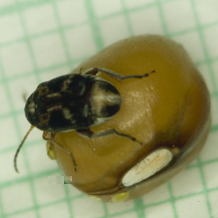ABSTRACTBean beetles (Callosobruchus maculatus) are phytophagous insects that lay their eggs on the surface of several species of beans in the family Fabaceae. Larval development is completed within the beanTherefore, we would expect strong selection when the beetle switches to a new host. Students are provided with live cultures of beetles containing adults that have been raised on mung beans(Phaseolus aureus) for many generations; they are also given cultures that were originally grown on mung beans, but were recently switched to another bean species. In this exercise, students design and conduct an experiment to determine whether beetles have adapted to the new host. In the first class period, students design and set up the experiment. In subsequent sessions, they isolate beans with eggs and record data on life history traits including time to emergence and mass at emergence to evaluate the success of beetles on their historic and novel hosts. Based on the pooled data from the entire class, each student writes a scientific paper. AUTHORSChristopher W. Beck1 and Lawrence S. Blumer2 1- Department of Biology, Emory University, Atlanta, GA 30322; christopher.beck@emory.edu 2- Department of Biology, Morehouse College, Atlanta, GA 30314; lblumer@morehouse.edu CLASS TIMEOne 2-3 hour class period and a 1 hour class period 48 hours later. OUTSIDE OF CLASS TIMEStudents will spend 15 minutes daily for 2 weeks between weeks 4 and 6 (approximately) after the experiment is established.In addition, they may spend several hours analyzing their data, conducting library research, and writing papers based on their results. STUDENT PRODUCTSEach student prepares a written scientific paper in the style of Ecology based on the pooled data from the entire class. SETTINGThe experiment is carried out entirely in the lab. COURSE CONTEXTThe experiment as described is used in an upper-level ecology course with a maximum of 24 students per lab section. INSTITUTIONThis experiment has been conducted at a mid-sized private university. Similar experiments have been conducted at a small private college. TRANSFERABILITYSince this exercise is a guided inquiry, it could be transferable to other levels, depending on the degree of support and direction given to the students as they design the experiment and analyze the data. Bean beetles have been used for other experiments in high school biology classes and are reliable experimental organisms. Other phytophagous insects that are easily reared in the laboratory and can be induced to use a variety of host plants, such as tobacco hornworms (Manduca sexta) and the Brassica butterfly (Pieris rapae), could be used in this experiment. ACKNOWLEDGMENTSWe thank Kathy Winnet-Murray and two anonymous reviewers whose comments improved this experiment. We also thank Nancy Bliwise and Pat Marsteller who pointed us toward grading rubrics that are available on the web. Development of this exercise was supported by the National Science Foundation (DUE-0535903). Any opinions, findings, and conclusions or recommendations expressed in this material are those of the authors and do not necessary reflect the views of the National Science Foundation. CITATIONChristopher W. Beck and Lawrence S. Blumer. 23 February 2009, posting date. Rapid adaptation of bean beetles to a novel host. Teaching Issues and Experiments in Ecology, Vol. 6: Experiment #1 [online]. http://tiee.ecoed.net/vol/v6/experiments/beetle_adaptation/abstract.html |

Female bean beetle on a mung bean (squares in mm). Photograph by L. Blumer. |
<top> | |